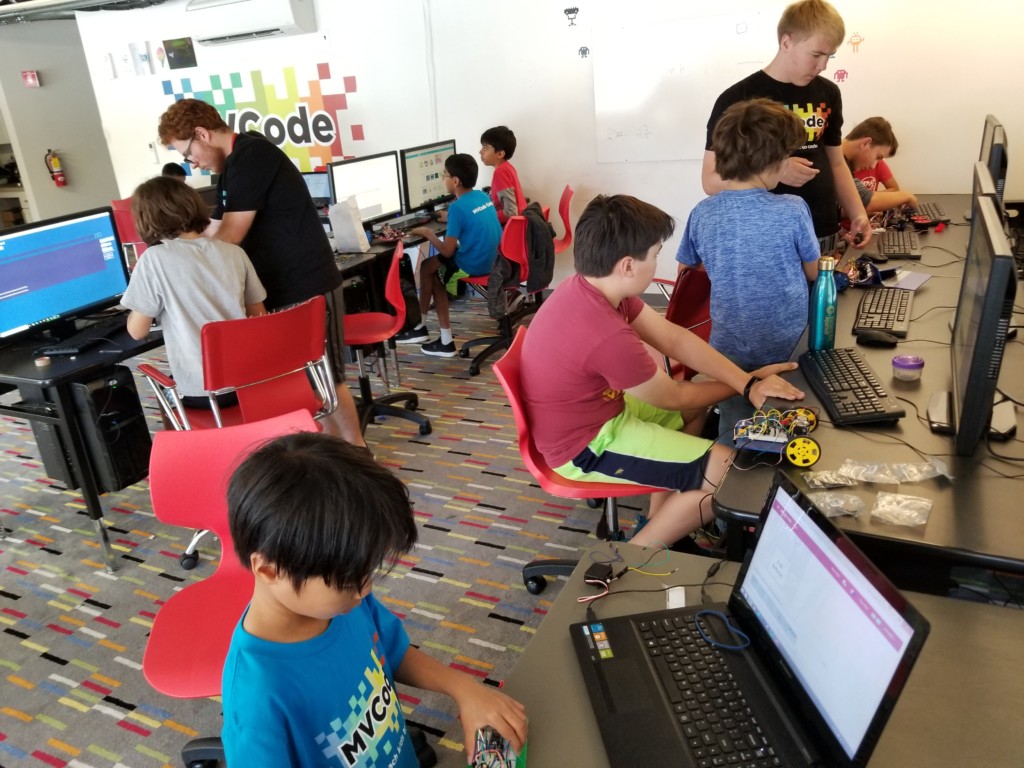(This post is in partnership with MVCode)

My parents are in town, and they get a kick out of pointing out unique “San Franciscan” things around the city, saying, “Only in San Francisco!” Recently, we walked past
MVCode and my mom asked what it was. I told her it’s an organization that teaches kids to code, and she predictably replied, “Only in San Francisco!” But in this case, the statement isn’t true. First, MVCode also has locations in Marin and on the Peninsula, but more importantly, there’s a national push to introduce coding to kids because it has benefits far beyond programming computers.
Teamwork and Social Time
Over the summer, the kids in MVCode’s camps would spend their lunch breaks at the playground at the end of my street. I’d see them walk down the street together, chatting and laughing, and I’d often observe them in action when I was at the playground, too, with my own kids. Some would run around, getting out their energy and the rest would read or play games at the picnic table together.
There’s a stereotype of coders sitting in a room wearing headphones, not interacting with the real world, but the kids I see at MVCode are experiencing something completely different. They’re connecting with peers who share their interests and, as a
guest writer for us explained, they’re working together on projects, learning valuable social skills and teamwork along the way.
Training Brains to Think Differently
Learning to code gives kids a new perspective on problem solving. They can’t whine, complain, or negotiate their way out of a problem with a computer. They must use logic and deductive reasoning to solve it. They gain confidence in themselves, knowing that problems can be solved if they keep trying. And they work on problems individually and together, which helps them build a well-rounded problem solving skill set.
Mastering Technology, Not Controlled By It
When my husband and I are stumped on a tech issue in our house, we call our friend, who was a computer science major, to help us out. We use technology all the time, but we really have no idea how it works. As technology gets more and more advanced, the breadth of our technological ignorance is only going to get worse. By teaching kids to code, they are learning fundamental skills to understand the technology they use every day, which helps limit the power it has over them. They’re not scared of it. They can conquer it and even envision themselves evolving it.
Learn Math and Science Concepts in a Fun Way
Learning to code offers kids the chance to design their own games and apps, which requires a working knowledge of some foundational math and science concepts. The founder of MVCode, Doug Tarr, explains,
“A big area of coding is in simulations. When kids are making a game or an app, they often want it to have ‘lifelike’ properties. For example, if they want to make their character jump, they don’t want him to float in the air or just immediately come up and down.
So, they’ll make their game, and they’ll ask how they do that. For example, how to make jumping more lifelike. They need to understand a few concepts. Gravity, and how that works. Velocity and acceleration, to model gravity. Positive and negative numbers, to model velocity and acceleration. Cartesian coordinates, to map it back to their characters on the screen.”
This is essentially learning through play, which we know is critical in early childhood development and many experts advocate should continue into grade school. MVCode is giving kids this chance.
Outlet for Creativity
Children who are drawn to coding often enjoy playing video games, and learning to code gives them the power to think about those games differently. Instead of saying, “I can play this,” they think, “I can make this.” They are inspired to create their own gaming worlds, and they learn how to do it.
Besides video games, learning computer science opens their world to design tools that let them work in graphic design, create music, edit movies, add special effects, develop stories and games, and even use computers to design physical objects.
If coding is the new literacy, then teaching children how to do it arms them with another tool for communication and an opportunity to express themselves. You can sign your child up for a free trial class at MVCode’s San Francisco, San Mateo, or Redwood City locations to see for yourself how learning to code can compliment your child’s other interests. MVCode hosts after school classes for students in 1st – 10th grades which are in full swing now (
click here for the full schedule).
In addition to the after school programs, MVCode offers
coding camps,
girls-only sessions, and on the weekends, MV Code members can participate in coding cup challenges (which also include outdoor activities) or drop in during open lab hours to continue working on their projects. This
Friday, September 14, the
Mills High School robotics team will even be showcasing their robots to MVCode’s teencode members at the San Mateo location.
By learning to code, our kids can develop a passion for technology and become role models in the tech field and beyond.
 My parents are in town, and they get a kick out of pointing out unique “San Franciscan” things around the city, saying, “Only in San Francisco!” Recently, we walked past MVCode and my mom asked what it was. I told her it’s an organization that teaches kids to code, and she predictably replied, “Only in San Francisco!” But in this case, the statement isn’t true. First, MVCode also has locations in Marin and on the Peninsula, but more importantly, there’s a national push to introduce coding to kids because it has benefits far beyond programming computers.
My parents are in town, and they get a kick out of pointing out unique “San Franciscan” things around the city, saying, “Only in San Francisco!” Recently, we walked past MVCode and my mom asked what it was. I told her it’s an organization that teaches kids to code, and she predictably replied, “Only in San Francisco!” But in this case, the statement isn’t true. First, MVCode also has locations in Marin and on the Peninsula, but more importantly, there’s a national push to introduce coding to kids because it has benefits far beyond programming computers. 





















